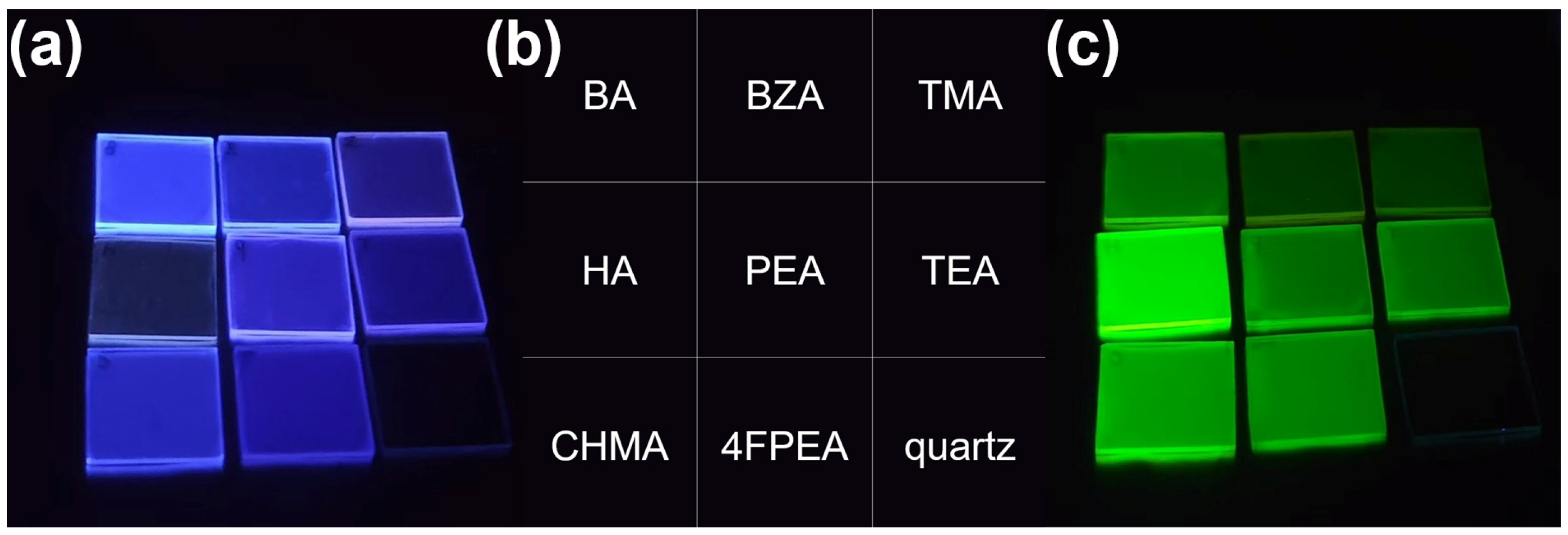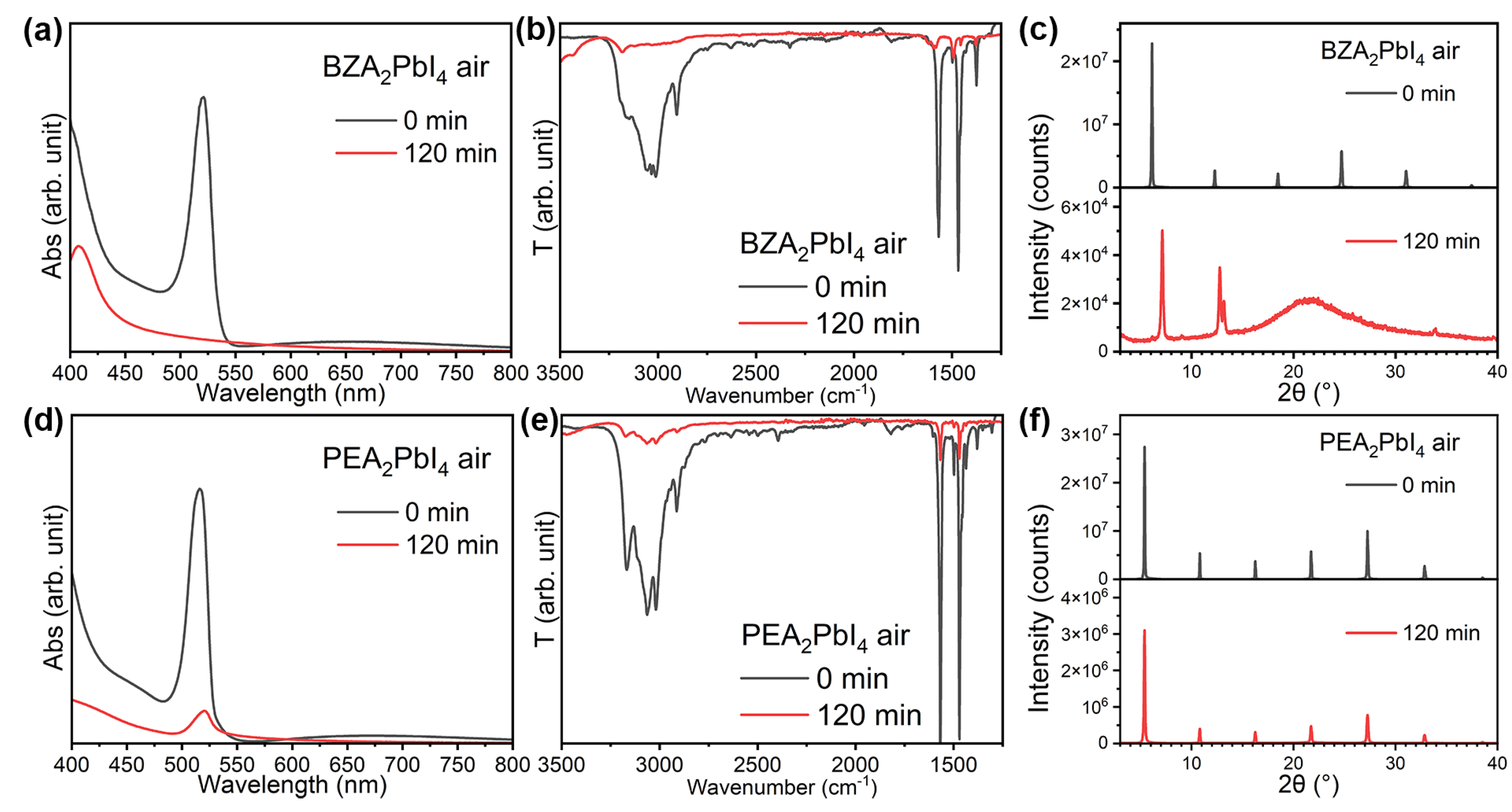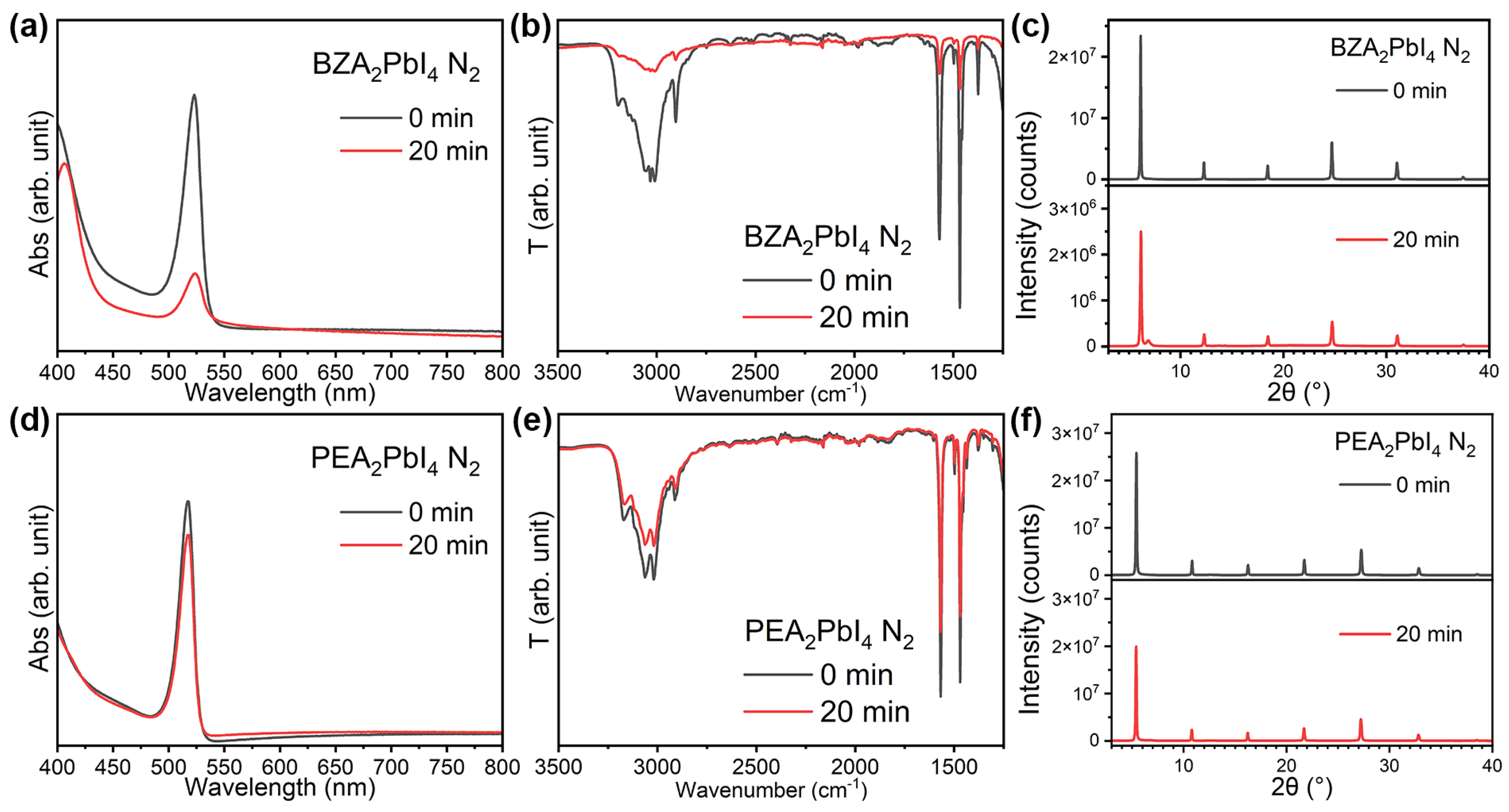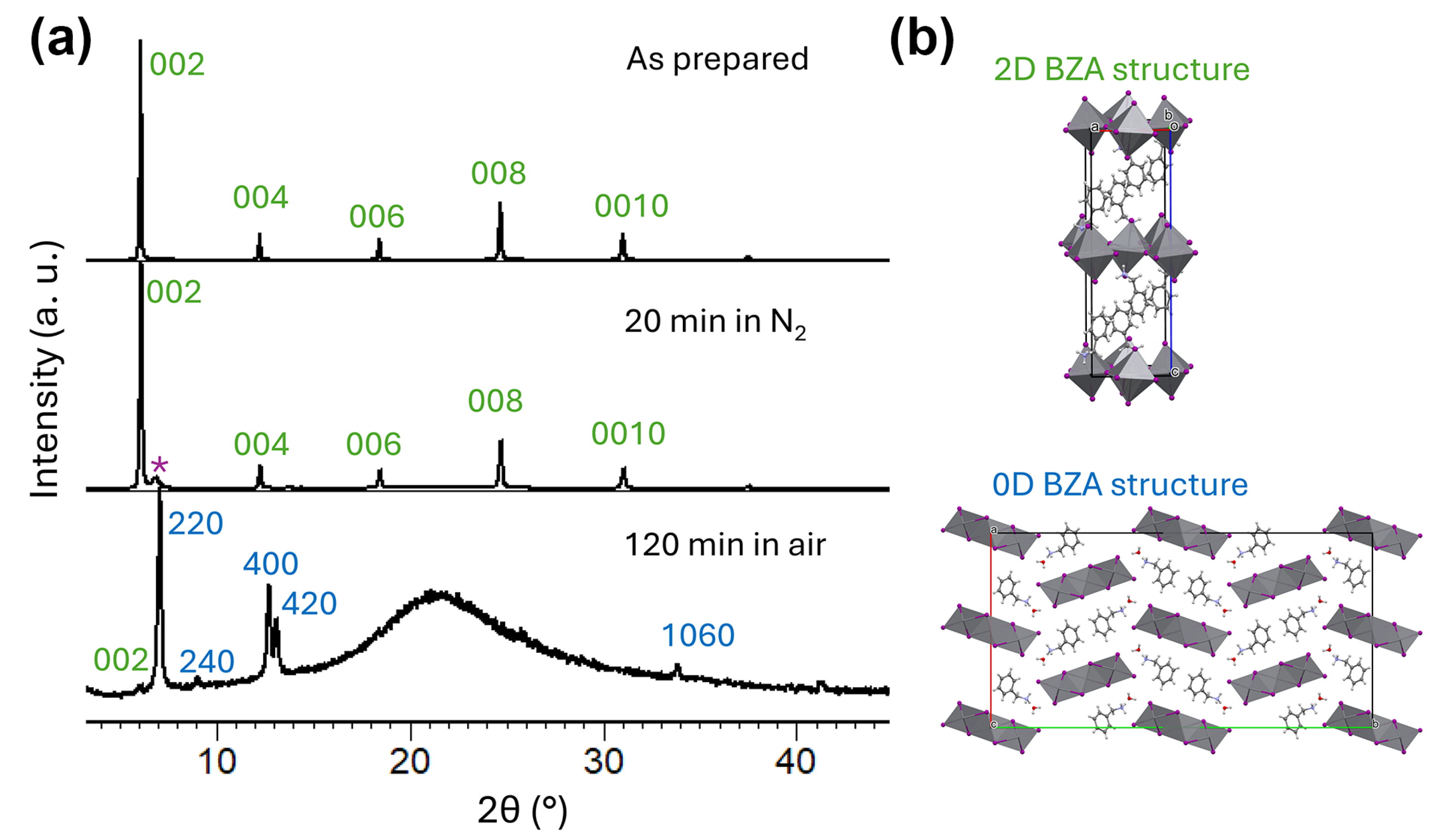Photoluminescence and Stability of 2D Ruddlesden–Popper Halide Perovskites
Abstract
1. Introduction
2. Results and Discussion
3. Materials and Methods
3.1. Experimental Techniques
3.2. Synthesis
4. Conclusions
Supplementary Materials
Author Contributions
Funding
Data Availability Statement
Conflicts of Interest
References
- Li, X.; Hoffman, J.M.; Kanatzidis, M.G. The 2D Halide Perovskite Rulebook: How the Spacer Influences Everything from the Structure to Optoelectronic Device Efficiency. Chem. Rev. 2021, 121, 2230–2291. [Google Scholar] [CrossRef]
- Zhou, N.; Zhou, H.P. Spacer Organic Cation Engineering for Quasi-2D Metal Halide Perovskites and the Optoelectronic Application. Small Struct. 2022, 3, 2100232. [Google Scholar] [CrossRef]
- Vasileiadou, E.S.; Kanatzidis, M.G. Structure-Property Relationships and Idiosyncrasies of Bulk, 2D Hybrid Lead Bromide Perovskites. Isr. J. Chem. 2021, 61, 782–817. [Google Scholar] [CrossRef]
- Leung, T.L.; Ahmad, I.; Syed, A.A.; Ng, A.M.C.; Popović, J.; Djurišić, A.B. Stability of 2D and quasi-2D perovskite materials and devices. Commun. Mater. 2022, 3, 63. [Google Scholar] [CrossRef]
- Mondal, S.; Eguchi, N.; Nishimura, N.; Hinuma, Y.; Yamamoto, K.; Kogo, A.; Murakami, T.N.; Kanda, H. Mixed 2D-cation passivation towards improved durability of perovskite solar cells and dynamics of 2D-perovskites under light irradiation and at high temperature. Sustain. Energy Fuels 2025, 9, 247. [Google Scholar] [CrossRef]
- Blancon, J.C.; Tsai, H.; Nie, W.; Stoumpos, C.C.; Pedesseau, L.; Katan, C.; Kepenekian, M.; Soe, C.M.M.; Appavoo, K.; Sfeir, M.Y.; et al. Extremely efficient internal exciton dissociation through edge states in layered 2D perovskites. Science 2017, 355, 1288–1292. [Google Scholar] [CrossRef]
- Mathew, P.; Cho, J.; Kamat, P.V. Ramifications of Ion Migration in 2D Lead Halide Perovskites. ACS Energy Lett. 2024, 9, 1103–1114. [Google Scholar] [CrossRef]
- Ren, Z.; Yuan, Z.; Ovčar, J.; Leung, T.L.; He, Y.L.; Ho-Baillie, A.W.Y.; Lončarić, I.; Popović, J.; Djurišić, A.B. Elucidation of the suppression of photoinduced segregation in 2D mixed halide, A2PbI2Br2: Critical role of A2PbBr4 photostability. iScience 2025, 28, 112154. [Google Scholar] [CrossRef]
- Yadav, A.N.; Min, S.; Choe, H.; Park, J.; Cho, J. Halide Ion Mixing across Colloidal 2D Ruddlesden-Popper Perovskites: Implication of Spacer Ligand on Mixing Kinetics. Small 2024, 20, 2305546. [Google Scholar] [CrossRef]
- Gan, L.; Li, J.; Fang, Z.; He, H.; Ye, Z. Effects of Organic Cation Length on Exciton Recombination in Two-Dimensional Layered Lead Iodide Hybrid Perovskite Crystals. J. Phys. Chem. Lett. 2017, 8, 5177–5183. [Google Scholar] [CrossRef]
- Zhang, J.; Wu, J.; Zhao, Y.; Zou, Y.; Barabash, A.; Wu, Z.; Zhang, K.; Deng, C.; Elia, J.; Li, C.; et al. Revealing the Crystallization and Thermal-Induced Phase Evolution in Aromatic-Based Quasi-2D Perovskites Using a Robot-Based Platform. ACS Energy Lett. 2023, 8, 3595–3603. [Google Scholar] [CrossRef]
- Kutkan, S.; Dhanabalan, B.; Lin, M.L.; Tan, P.H.; Schleusener, A.; Arciniegas, M.P.; Krahne, R. Impact of the organic cation on the band-edge emission of two-dimensional lead–bromide perovskites. Nanoscale 2023, 15, 12880. [Google Scholar] [CrossRef] [PubMed]
- Maulida, P.Y.D.; Hartati, S.; Kowal, D.; Diguna, L.J.; Sheikh, M.A.K.; Mahyuddin, M.H.; Mulyani, I.; Onggo, D.; Maddalena, F.; Bachiri, A.; et al. Organic Chain Length Effect on Trap States of Lead Halide Perovskite Scintillators. ACS Appl. Energy Mater. 2023, 6, 5912–5922. [Google Scholar] [CrossRef]
- Qing, J.; Ramesh, S.; Liu, X.K.; Wang, H.; Yu, H.; Kuang, C.; Hou, L.; Zhang, W.; Sum, T.C.; Gao, F. Spacer cation engineering in Ruddlesden-Popper perovskites for efficient red light-emitting diodes with recommendation 2020 color coordinates. Appl. Surf. Sci. 2023, 616, 156454. [Google Scholar] [CrossRef]
- Krahne, R.; Schleusener, A.; Faraji, M.; Li, L.H.; Lin, M.L.; Tan, P.H. Phonon Directionality Impacts Electron−Phonon Coupling and Polarization of the Band-Edge Emission in Two-Dimensional Metal Halide Perovskites. Nano Lett. 2024, 24, 11124–11131. [Google Scholar] [CrossRef]
- Marjit, K.; Francis, A.G.; Pati, S.K.; Patra, A. Impacts of Exciton Binding Energy and Dielectric Confinement of Layered Lead Halide Perovskites on Carrier Relaxation and Exciton Phonon Interactions. J. Phys. Chem. Lett. 2023, 14, 10900–10909. [Google Scholar] [CrossRef] [PubMed]
- Ribeiro, I.C.; Moraes, P.I.R.; Bittencourt, A.F.B.; Da Silva, J.L.F. Unveiling the impact of organic cation passivation on structural and optoelectronic properties of two-dimensional perovskites thin films. Appl. Surf. Sci. 2024, 678, 161098. [Google Scholar] [CrossRef]
- Dahlman, C.J.; Kennard, R.M.; Paluch, P.; Venkatesan, N.R.; Chabinyc, M.L.; Reddy, G.N.M. Dynamic Motion of Organic Spacer Cations in Ruddlesden−Popper Lead Iodide Perovskites Probed by Solid-State NMR Spectroscopy. Chem. Mater. 2021, 33, 642–656. [Google Scholar] [CrossRef]
- Vasileiadou, E.S.; Hadar, I.; Kepenekian, M.; Even, J.; Tu, Q.; Malliakas, C.D.; Friedrich, D.; Spanopoulos, I.; Hoffman, J.M.; Dravid, V.P.; et al. Shedding Light on the Stability and Structure−Property Relationships of Two-Dimensional Hybrid Lead Bromide Perovskites. Chem. Mater. 2021, 33, 5085–5107. [Google Scholar] [CrossRef]
- Lin, C.W.; Liu, F.Z.; Chen, T.Y.; Lee, K.H.; Chang, C.K.; He, Y.L.; Leung, T.L.; Ng, A.M.C.; Hsu, C.H.; Popović, J.; et al. Structure-Dependent Photoluminescence in Low-Dimensional Ethylammonium, Propylammonium, and Butylammonium Lead Iodide Perovskites. ACS Appl. Mater. Interfaces 2020, 12, 5008–5016. [Google Scholar] [CrossRef]
- Spanopoulos, I.; Hadar, I.; Ke, W.; Tu, Q.; Chen, M.; Tsai, H.; He, Y.; Shekhawat, G.; Dravid, V.P.; Wasielewski, M.R.; et al. Uniaxial Expansion of the 2D Ruddlesden−Popper Perovskite Family for Improved Environmental Stability. J. Am. Chem. Soc. 2019, 141, 5518–5534. [Google Scholar] [CrossRef] [PubMed]
- Kim, D.; Vasileiadou, E.S.; Spanopoulos, I.; Kanatzidis, M.G.; Tu, Q. In-Plane Mechanical Properties of Two-Dimensional Hybrid Organic−Inorganic Perovskite Nanosheets: Structure−Property Relationships. ACS Appl. Mater. Interfaces 2021, 13, 31642–31649. [Google Scholar] [CrossRef]
- Gong, X.; Voznyy, O.; Jain, A.; Liu, W.; Sabatini, R.; Piontkowski, Z.; Walters, G.; Bappi, G.; Nokhrin, S.; Bushuyev, O.; et al. Electron-phonon interaction in efficient perovskite blue emitters. Nat. Mater. 2018, 17, 550–556. [Google Scholar] [CrossRef]
- Han, D.; Chen, S.; Du, M.H. Role of Polycyclic Aromatic Alkylammonium Cations in Tuning the Electronic Properties and Band Alignment of Two-Dimensional Hybrid Perovskite Semiconductor. J. Phys. Chem. Lett. 2021, 12, 9754–9760. [Google Scholar] [CrossRef] [PubMed]
- Vasileiadou, E.S.; Jiang, X.; Kepenekian, M.; Even, J.; De Siena, M.C.; Klepov, V.V.; Friedrich, D.; Spanopoulos, I.; Tu, Q.; Tajuddin, I.S.; et al. Thick-Layer Lead Iodide Perovskites with Bifunctional Organic Spacers Allylammonium and Iodopropylammonium Exhibiting Trap-State Emission. J. Am. Chem. Soc. 2022, 144, 6390–6409. [Google Scholar] [CrossRef] [PubMed]
- Liang, M.; Lin, W.; Zhao, Q.; Zou, X.; Lan, Z.; Meng, J.; Shi, Q.; Castelli, I.E.; Canton, S.E.; Pullerits, T.; et al. Free Carriers versus Self-Trapped Excitons at Different Facets of Ruddlesden−Popper Two-Dimensional Lead Halide Perovskite Single Crystals. J. Phys. Chem. Lett. 2021, 12, 4965–4971. [Google Scholar] [CrossRef]
- Saadatmand, S.B.; Shokouhi, S.; Ahmadi, V.; Hamidi, S.M. Metastructure Engineering with Ruddlesden–Popper 2D Perovskites: Stability, Flexibility, and Quality Factor Trade-Offs. ACS Omega 2024, 9, 24925–24932. [Google Scholar] [CrossRef]
- Ren, Z.; Ovčar, J.; Leung, T.L.; He, Y.; Li, Y.; Li, D.; Qin, X.; Mo, H.; Yuan, Z.; Bing, J.; et al. Increased Resistance to Photooxidation in Dion-Jacobson Lead Halide Perovskites: Implication for Perovskite Device Stability. Matter 2025, 8, 101937. [Google Scholar] [CrossRef]
- Hossain, T.; Atapattu, H.R.; Pruett, H.; Rahman, M.T.; Pedersen, K.R.; Huckaba, A.J.; Parkin, S.R.; Graham, K.R. Effects of A-Site Cation Structure on the Stability of 2D Tin Halide Perovskites. Chem. Mater. 2024, 36, 11004–11014. [Google Scholar] [CrossRef]
- Sheikh, T.; Shinde, A.; Mahamuni, S.; Nag, A. Dual excitonic emissions and structural phase transition of octylammonium lead iodide 2D layered perovskite single crystal. Mater. Res. Express 2019, 6, 124002. [Google Scholar] [CrossRef]
- Sheikh, T.; Shinde, A.; Mahamuni, S.; Nag, A. Possible Dual Bandgap in (C4H9NH3)2PbI4 2D Layered Perovskite: Single-Crystal and Exfoliated Few-Layer. ACS Energy Lett. 2018, 3, 2940–2946. [Google Scholar] [CrossRef]
- Chirvony, V.S.; Suárez, I.; Rodríguez-Romero, J.; Vázquez-Cárdenas, R.; Sanchez-Diaz, J.; Molina-Sánchez, A.; Barea, E.M.; Mora-Seró, I.; Martínez-Pastor, J.P. Inhomogeneous Broadening of Photoluminescence Spectra and Kinetics of Nanometer-Thick (Phenethylammonium)2PbI4 Perovskite Thin Films: Implications for Optoelectronics. ACS Appl. Nano Mater. 2021, 4, 6170–6177. [Google Scholar] [CrossRef] [PubMed]
- Levine, I.; Menzel, D.; Musiienko, A.; MacQueen, R.; Romano, N.; Vasquez-Montoya, M.; Unger, E.; Perez, C.M.; Forde, A.; Neukirch, A.J.; et al. Revisiting Sub-Band Gap Emission Mechanism in 2D Halide Perovskites: The Role of Defect States. J. Am. Chem. Soc. 2024, 146, 23437–23448. [Google Scholar] [CrossRef] [PubMed]
- Hou, Y.; Zheng, F.; Yang, L.; Qi, X.; Ma, G.; Luo, Z.; Zhao, Z.; Wang, X.; Zhao, Z.; Hu, Z. Evolution of Two-Dimensional Perovskite Films Under Atmospheric Exposure and Its Impact on Photovoltaic Performance. ACS Appl. Mater. Interfaces 2025, 17, 3806–3817. [Google Scholar] [CrossRef]
- Zhong, C.; Che, X.; Xu, C.; Chen, C.; Yang, C.; Zhu, Y. Instability of two-dimensional hybrid perovskites underpinned by organic molecule loss under light illumination. Mater. Chem. Front. 2024, 8, 2836–2844. [Google Scholar] [CrossRef]
- Fang, H.H.; Yang, J.; Tao, S.; Adjokatse, S.; Kamminga, M.E.; Ye, J.; Blake, G.R.; Even, J.; Loi, A.M. Unravelling Light-Induced Degradation of Layered Perovskite Crystals and Design of Efficient Encapsulation for Improved Photostability. Adv. Funct. Mater. 2018, 28, 1800305. [Google Scholar] [CrossRef]
- Udalova, N.N.; Fateev, S.A.; Nemygina, E.M.; Zanetta, A.; Grancini, G.; Goodilin, E.A.; Tarasov, A.B. Nonmonotonic Photostability of BA2MAn−1PbnI3n+1 Homologous Layered Perovskites. ACS Appl. Mater. Interfaces 2022, 14, 961–970. [Google Scholar] [CrossRef]
- Mathew, P.S.; Szabó, G.; Kuno, M.; Kamat, P.V. Phase Segregation and Sequential Expulsion of Iodide and Bromide in Photoirradiated Ruddlesden-Popper 2D Perovskite Films. ACS Energy Lett. 2022, 7, 3982–3988. [Google Scholar] [CrossRef]
- Mao, L.; Tsai, H.; Nie, W.; Ma, L.; Im, J.; Stoumpos, C.C.; Malliakas, C.D.; Hao, F.; Wasielewski, M.R.; Mohite, A.D.; et al. Role of Organic Counterion in Lead- and Tin-Based Two-Dimensional Semiconducting Iodide Perovskites and Application in Planar Solar Cells. Chem. Mater. 2016, 28, 7781–7792. [Google Scholar] [CrossRef]
- Oswald, I.W.H.; Koegel, A.A.; Neilson, J.R. General Synthesis Principles for Ruddlesden–Popper Hybrid Perovskite Halides from a Dynamic Equilibrium. Chem. Mater. 2018, 30, 8606–8614. [Google Scholar] [CrossRef]
- Calabrese, J.; Jones, N.L.; Harlow, R.L.; Herron, N.; Thorn, D.L.; Wang, Y. Preparation and characterization of layered lead halide compounds. J. Am. Chem. Soc. 1991, 113, 2328–2330. [Google Scholar] [CrossRef]
- Jasti, N.P.; Levine, I.; Feldman, Y.I.; Hodes, G.; Aharon, S.; Cahen, D. Experimental evidence for defect tolerance in Pb halide perovskites. Proc. Nat. Acad. Sci. USA 2024, 121, e2316867121. [Google Scholar] [CrossRef]
- Ceratti, D.R.; Ron Tenne, R.; Bartezzaghi, A.; Cremonesi, L.; Segev, L.; Kalchenko, V.; Oron, D.; Potenza, M.A.C.; Hodes, G.; Cahen, D. Self-Healing and Light-Soaking in MAPbI3: The Effect of H2O. Adv. Mater. 2022, 34, 2110239. [Google Scholar] [CrossRef]
- Aharon, S.; Ceratti, D.R.; Jasti, N.P.; Cremonesi, L.; Feldman, Y.; Potenza, M.A.C.; Hodes, G.; Cahen, D. 2D Pb-Halide Perovskites Can Self-Heal Photodamage Better than 3D Ones. Adv. Funct. Mater. 2022, 32, 2113354. [Google Scholar] [CrossRef]
- Straus, D.B.; Iotov, N.; Gau, M.R.; Zhao, Q.; Carroll, P.J.; Kagan, C.R. Longer Cations Increase Energetic Disorder in Excitonic 2D Hybrid Perovskites. J. Phys. Chem. Lett. 2019, 10, 1198–1205. [Google Scholar] [CrossRef]
- Jung, M.H. Exploration of two-dimensional perovskites incorporating methylammonium for high performance solar cells. CrystEngComm 2021, 23, 1181–1200. [Google Scholar] [CrossRef]
- Chiavarino, B.; Crestoni, M.E.; Schütz, M.; Bouchet, A.; Piccirillo, S.; Steinmetz, V.; Dopfer, O.; Fornarini, S. Cation−π Interactions in Protonated Phenylalkylamines. J. Phys. Chem. A 2014, 118, 7130–7138. [Google Scholar] [CrossRef]
- Batatia, I.; Kovacs, D.P.; Simm, G.N.C.; Ortner, C.; Csanyi, G. MACE: Higher Order Equivariant Message Passing Neural Networks for Fast and Accurate Force Fields, Proceedings, Advances in Neural Information Processing Systems 35 (NeurIPS 2022). arXiv 2022, arXiv:2206.07697. [Google Scholar] [CrossRef]
- Batatia, I.; Batzner, S.; Kovács, D.P.; Musaelian, A.; Simm, G.N.C.; Drautz, R.; Ortner, C.; Kozinsky, B.; Csányi, G. The Design Space of E(3)-Equivariant Atom-Centered Interatomic Potentials. arXiv 2022, arXiv:2205.06643. [Google Scholar] [CrossRef]
- Karimitari, N.; Baldwin, W.J.; Muller, E.W.; Bare, Z.J.L.; Kennedy, W.J.; Csányi, G.; Sutton, C. JACS Accurate Crystal Structure Prediction of New 2D Hybrid Organic–Inorganic Perovskites. J. Am. Chem. Soc. 2024, 146, 27392–27404. [Google Scholar] [CrossRef] [PubMed]
- Larsen, A.H.; Mortensen, J.J.; Blomqvist, J.; Castelli, I.E.; Christensen, R.; Dułak, M.; Friis, J.; Groves, M.N.; Hammer, B.; Hargus, C.; et al. The atomic simulation environment—A Python library for working with atoms. J. Phys. Condens. Matter 2017, 29, 273002. [Google Scholar] [CrossRef] [PubMed]






Disclaimer/Publisher’s Note: The statements, opinions and data contained in all publications are solely those of the individual author(s) and contributor(s) and not of MDPI and/or the editor(s). MDPI and/or the editor(s) disclaim responsibility for any injury to people or property resulting from any ideas, methods, instructions or products referred to in the content. |
© 2025 by the authors. Licensee MDPI, Basel, Switzerland. This article is an open access article distributed under the terms and conditions of the Creative Commons Attribution (CC BY) license (https://creativecommons.org/licenses/by/4.0/).
Share and Cite
Ren, Z.; Yuan, Z.; Sergeev, A.A.; Lončarić, I.; Ali, M.U.; Rehman, A.U.; Wong, K.S.; He, Y.; Ovčar, J.; Popović, J.; et al. Photoluminescence and Stability of 2D Ruddlesden–Popper Halide Perovskites. Molecules 2025, 30, 2716. https://doi.org/10.3390/molecules30132716
Ren Z, Yuan Z, Sergeev AA, Lončarić I, Ali MU, Rehman AU, Wong KS, He Y, Ovčar J, Popović J, et al. Photoluminescence and Stability of 2D Ruddlesden–Popper Halide Perovskites. Molecules. 2025; 30(13):2716. https://doi.org/10.3390/molecules30132716
Chicago/Turabian StyleRen, Zhilin, Zhengtian Yuan, Aleksandr A. Sergeev, Ivor Lončarić, Muhammad Umair Ali, Atta Ur Rehman, Kam Sing Wong, Yanling He, Juraj Ovčar, Jasminka Popović, and et al. 2025. "Photoluminescence and Stability of 2D Ruddlesden–Popper Halide Perovskites" Molecules 30, no. 13: 2716. https://doi.org/10.3390/molecules30132716
APA StyleRen, Z., Yuan, Z., Sergeev, A. A., Lončarić, I., Ali, M. U., Rehman, A. U., Wong, K. S., He, Y., Ovčar, J., Popović, J., & Djurišić, A. B. (2025). Photoluminescence and Stability of 2D Ruddlesden–Popper Halide Perovskites. Molecules, 30(13), 2716. https://doi.org/10.3390/molecules30132716






